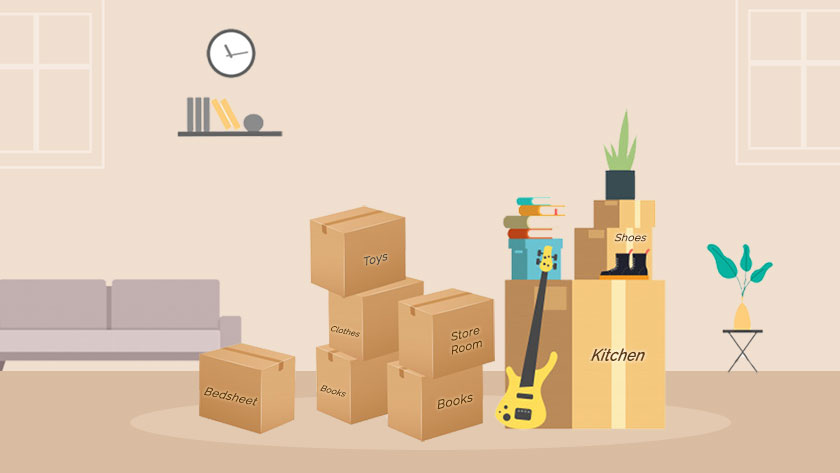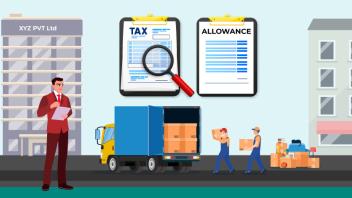Label Boxes For Household Shifting: Organize Your Move

Moving is popularly known as one of the most stressful tasks which can quickly drain your physical, mental, and financial strengths. Moreover, this can multiply by tenfold if you’re moving for the very first time. Moving your entire household can make you realize 2 main things – the number of items you accumulated over the years, and how difficult it will be to organize everything.
When you have a large number of items, you can solve the problem easily by sorting through all the items and getting rid of the things which you do not use anymore. The other issue related to organizing also has an easy (and fun!) solution, which is nothing but labeling all your packed boxes.
People usually underestimate the benefits of labeling boxes and miss out on the best ways in which they can simplify their move to a great extent; but, don’t be one of those people. Instead, learn about how to prepare for labeling, when is the best time to label, what are the different techniques you can follow, and you can finally decide which one will suit you the best.
Read on below to get the complete idea on how you can label the boxes like a pro.
Table of Contents
- Why is it Important to Label Boxes?
- How to Prepare for Labelling?
- When is the Right Time to Label Boxes?
- How to Label Moving Boxes?
- What to Write on the Boxes?
- Which Side to Label the Boxes?
Why is it Important to Label Boxes?
Imagine being surrounded by 20 to 30 carton boxes in your living room, not knowing which box to begin unpacking or in which room to place the boxes. Although chaos increases and your patience levels decrease, you can’t seem to find a way out of it.
This is the exact situation where labeling would have made your life easier. Choosing to describe what items are placed in which box as when they get packed will help you locate the items quickly and makes the unpacking simpler. Also, it will help your movers to easily understand how each box should be handled and which box should be loaded into the truck first.
By labeling your boxes, you achieve 4 main tasks:
- Easy guide to place boxes in their respective room;
- You can give handling instructions for each box;
- You can keep track of any missing or damaged boxes;
- You can also get to know which box you should unpack first;
But, what’s the most effective way of labeling? Which method of labeling suits you? What all do you need before you begin labeling? You can find the answers to all these questions below and choose the best-suited labeling method for you.
How to Prepare for Labelling?
Once you get to know the preparations you need to do before labeling, you’ll soon realize how easy and straightforward it is. Here are a few essential things you need to keep ready before you begin the process:
Buy Good-Quality Markers
The human brain processes colors and visuals much more easily and quickly than words. Therefore, the best way to calm your mind is to make use of colors.
Using a simple black marker is not going to help simplify labeling, and may only lead to more confusion and waste of time since you’ll have to read the labels to decide what to do with it.
- Buy different colored markers of good quality according to the number of rooms in your new home.
- Get water-proof permanent markers that do not get smudged or washed away (in case it rains on moving day).
- Try to use only dark colors, which are easy to see and readable.
Get Coloured Tapes and Labels
You can take your labeling game to the next level by using tapes of different colors instead of the usual transparent or brown tape. Along with the markers, colored tape adds another level of identity to each box and makes it easy to point out which box goes into which room.
Instead of writing on the cardboard box itself, you can use labels of plain or colored paper; either you can make them on your own or use pre-printed ones. Before sticking labels onto the boxes, first inspect the cartons for any old labels; remove them, or put your labels on top of the older ones to avoid confusion.
Note: Using colored labels is optional even though it makes the task of moving boxes around much easier; you can choose to move the boxes without sticking the labels as well, as long as you’re using some other form of clear labeling system for the cartons.
When is the Right Time to Label Boxes?
Now that your labeling toolkit is ready, it’s time to decide on the right time at which you should label the boxes.
That’s why, before we get into detail about the different methods of labeling, we would like to elaborate on how important it is to choose the PERFECT moment.
Although it seems like a trivial matter, getting the timing right is very important, especially considering the amount of stress and heap loads of tasks you have to handle during the relocation.
You cannot label the box BEFORE packing since you would not know what items will go in. Similarly, you cannot label LONG AFTER you pack a particular box since you could easily forget what things you put in it by then.
The perfect time to label a box is as soon as you’re done packing and sealing it!
So, remember – PACK, SEAL, and LABEL.
Also Read: How to Lift Heavy Boxes Correctly: The Complete Guide
How to Label Moving Boxes?
Develop a Colour-Coding System
Come up with a color-coding system using colors to identify the different rooms of your new house and use the same colored tapes while packing the items belonging to that room. You can assign any color to the rooms depending on what makes sense for you and is easy to remember.
For example: since green vegetables are used in the kitchen, it makes sense to use GREEN for the KITCHEN; water is blue, and lots of water is used in the bathroom, so BLUE is for BATHROOM; similarly assign RED for the BEDROOM, ORANGE for the LIVING ROOM, and so on. While packing, use the same color tapes to wrap the boxes, i.e., use Red tape for Bedroom boxes and Green tape for Kitchen boxes, etc.
To make it easy for the movers to identify which room a particular box has to go into, put the corresponding colored tapes on the destination doors. In simple words, put up green colored tape on the kitchen door to indicate that the boxes wrapped in green tape should be placed in the kitchen.
Note: You could decide the color codes before, or after buying the markers, i.e., you can assign the colors to the rooms first and then buy those color markers, or you could first buy the pens of your choice and then assign those colors to rooms.
Use the Room-Naming Technique
Giving a unique name to each room of your new house will help locate exactly where the boxes should go. For example, if you’re moving into a 3-bedroom home and all your bedroom boxes get labeled as just ‘Bedroom,’ you wouldn’t have a clue about which bedroom the boxes belong to.
To avoid this situation, it would help if you named each room and label the boxes accordingly, like ‘Master Bedroom,’ ‘Kid’s Room,’ ‘Guest Room,’ ‘Living Room,’ etc. By doing so, it also becomes easy to place the boxes in their respective rooms as soon as they are unloaded.
Label using Number Coded System
Another method of labeling the packed boxes is by using a number coded system in which different numbers are allocated to each box. This may be a lot quicker than color-coded labeling since you will simply have to designate and write a unique number on each box, such as #1 for Bedroom, #2 for Kitchen, and so on.
The main advantage of the number coded system of labeling is – the process involves taking a master inventory list of all your items.
For example: when you have numbered the box containing kitchen items as #2, you can note down the list of items contained in box #2 on your phone or notepad. This will come in handy while unpacking; you’ll know exactly which box to open to get the coffee maker out at the end of the day.
Note:
- While marking numbers on the packed boxes, it would help if you label the respective rooms; e.g., you can label box #2 as ‘Kitchen’ (preferably following the color-coding system) so that the movers directly place it in the kitchen.
- Also, the numbering will help you quickly find out if any box is missing or damaged; you can cross-check the list of items that went missing or got damaged by taking out your master inventory list.
Use Specialty Labels for Specialty Items
When delicate items are packed (like glassware, dinner set, light fixtures, etc.) make sure to label these boxes clearly as fragile so that movers know to handle them correctly. If the boxes packed with antiques and specialty items are not clearly marked, the movers will treat them as regular boxes, which may lead to many damages.
To make identification of these boxes easy, you can consider using completely different color codes (tapes, markers, and labels).
Label according to Priority
Another method of labeling the boxes is according to the priority level. This can help in two ways:
- During loading-unloading – so that the movers know beforehand which boxes to load first and which one would be loaded last.
- During unpacking – so that you can remember which box to unpack first and which one can wait until the last minute to be emptied.
You can mark the boxes as ‘H’ indicating High Priority, ‘M’ for Medium Priority and ‘L’ for Low Priority.
What to Write on the Boxes?
Destination Room
If you’re using the Color-Coding System: according to the color you assigned for each room, use the corresponding colored tape to wrap the box containing items of that particular room. (E.g., Green tape for Kitchen boxes)
If you’re using the Room-Naming Technique: write the name of the room in which the box should be placed along with the items kept inside that box for more clarity (writing list of things is optional). (E.g., Bedroom – Bed sheets, Pillow covers, Blanket)
If you’re using the Number Coded System: write the number which you assigned for that room along with its name. (E.g., #1 Bedroom, #2 Kitchen)
Handling Instructions
When the box contains easily breakable items, write the handling instructions clearly and make sure it is fully visible – ‘Fragile,’ ‘Handle with Care,’ ‘Delicate,’ ‘This Side Up,’ and so on. Preferably use a completely different color which hasn’t been used on any of the boxes until now.
Priority Indicator
When you need to let the movers know which box should be loaded first, or for you to remember which box should be unpacked first, write ‘H’ for High Priority, ‘M’ for Medium Priority, and ‘L’ for Low Priority.
Which Side to Label the Boxes?
The most obvious place where people usually label boxes is on the top or any one side of the carton.
However, the best way to label the box will be to write or stick the corresponding labels on at least 2 or 3 sides of the box and also on the top. This way, identifying the box becomes easy, no matter in which direction it is placed.
Also, it’s important to remember to write handling instructions very clearly and in a big font so that it is seen first before picking it up and moving it.
No matter which method of labeling you choose, try to involve attractive colors in the process; choose colors which have a relatable meaning behind them. Make sure you note down which colors or numbers you assign to which room so that you don’t forget or become confused at the last minute.
We understand that you’ll be completely stressed out while preparing for the move and you would not like to do more work. However, labeling is one such task which will reduce your stress by a great extent since half the work of matching boxes and their destination rooms becomes easy before you even begin moving. Not only that, but it also makes the process of moving a little more fun and colorful for you, which is another stress-buster.
Go on, add color to your move, and have fun!











